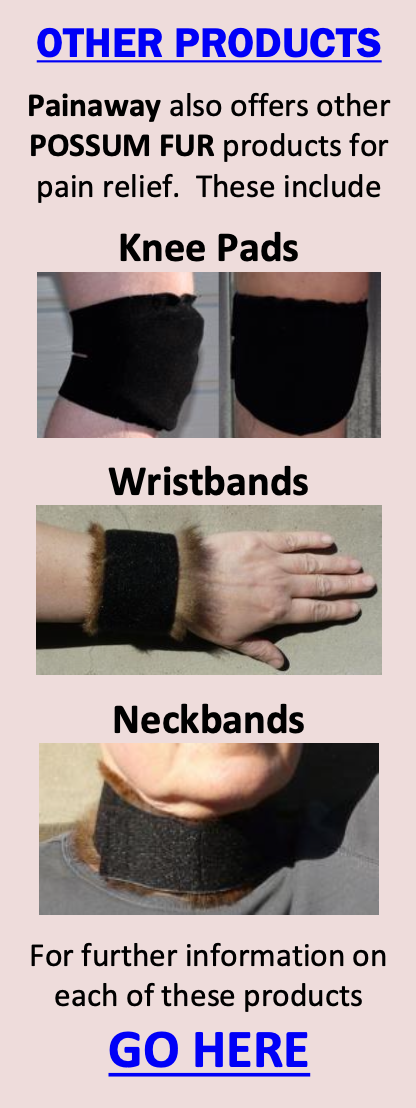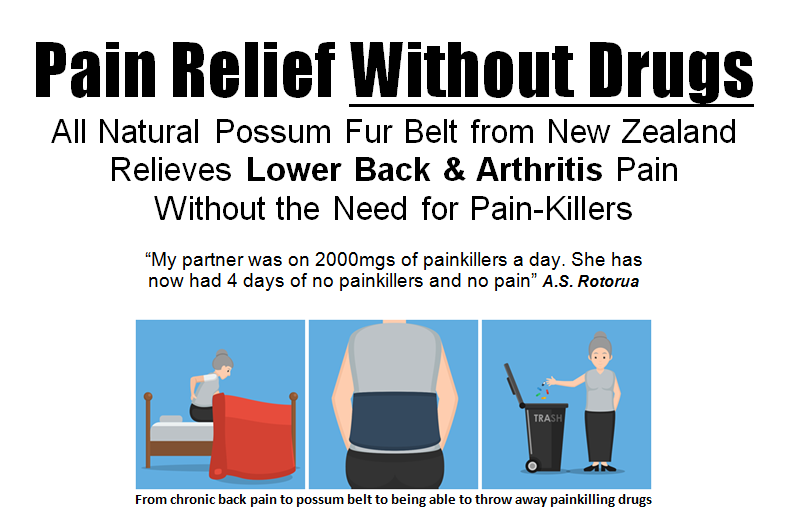
You’ve tried virtually everything – but your lower back pain refuses to go away. Causes can be varied – pulled muscles, arthritis or sciatica. You are now at your wits’ end. In desperation you may even be thinking of an operation but hesitate because of the small, but nevertheless real chance that things could go from bad to worse. When it comes to lower back pain you are not alone.
An estimated 540 million people worldwide currently suffer from back pain in varying degrees. Medical studies indicate that up to 80% of a country’s population will at some stage or other during their lives be affected by lower back pain. For some, the pain goes away quickly but for others, no ‘cure’ seems to work.
Now there is an answer. It is not a cure but it can provide much needed pain relief, enabling sufferers to return to work and once again go about their daily business. And that, no doubt, is where you’d like to be. As the headline indicates the answer lies in fur, not any fur, but possum fur from that most noxious of pests, the Australian brushtail possum (which comes from our friends across the Tasman – but that’s another story – see Box).
How the Possum came to New Zealand
The Australian brushtail possum, a cat-sized marsupial, was introduced to New Zealand in 1837 for the fur trade. In Australia, the possum is protected as a native species since its numbers are well under control due to superior predators such as snakes, owls and wild dogs. But in New Zealand there are no snakes, dangerous owls or wild dogs. Accordingly, possum numbers have mushroomed out of control and become the country’s most damaging animal pest, wreaking havoc on native forests and endangered bird species alike.
How Possum Fur Pain Relief Works
As you are no doubt aware the application of heat pads to an area affected by lower back pain more often than not provides relief since the packs help to warm the muscles and enable movement to take place. The problem is that heat pads eventually cool down, sometimes quite quickly, and then you are back to square one. With heat gone, the pain returns.
Others have tried using pads that trap heat such as pads made of wool or other animal furs. The problem is that these ‘natural’ products do not breathe and as a result there is a heat build up. This results in the wearer becoming hot, sweaty and sticky. After a period all the wearer wants to do is remove the pad. However, there is one product that does work and that is possum fur, when worn directly against the skin.
Possums and Polar Bears are unique in that theirs is the only fur which actually breathes. This is because the individual strands of hair in these animals are hollow. Being a protected species the use of Polar Bear fur is out of the question. But pesky New Zealand possums are another story.
The Brush Tail Possum is a certified pest that runs rampant throughout the forests of New Zealand eating anything and everything. As well as vegetation this includes small protected birds, their chicks and eggs. It is estimated that there are around 30 million possums rampaging the forests of New Zealand, consuming around 20,000 tonnes of vegetation and smaller wildlife every night.
This ability of possum fur to breathe is the principal reason why it provides pain relief when worn against the skin while other furs do not. The hollow fibres provide thermal stability to the area of the body where the fur is positioned (eg lower back).
This stabilising effect helps to maintain a constant temperature several degrees warmer than the skin surface. It also prevents perspiration, condensation and stickiness building up on the skin as the hollow fur fibres assist evaporation of surface moisture.
The pain relief that comes from wearing the belt arises from a medical effect called ‘effleurage’ which means a gentle stroking of the skin. This stroking stimulates the skin around the areas affected by pain. It confuses nerve pathways by sending pleasurable signals to the brain which in turn over-ride any feelings of pain. It’s that simple.
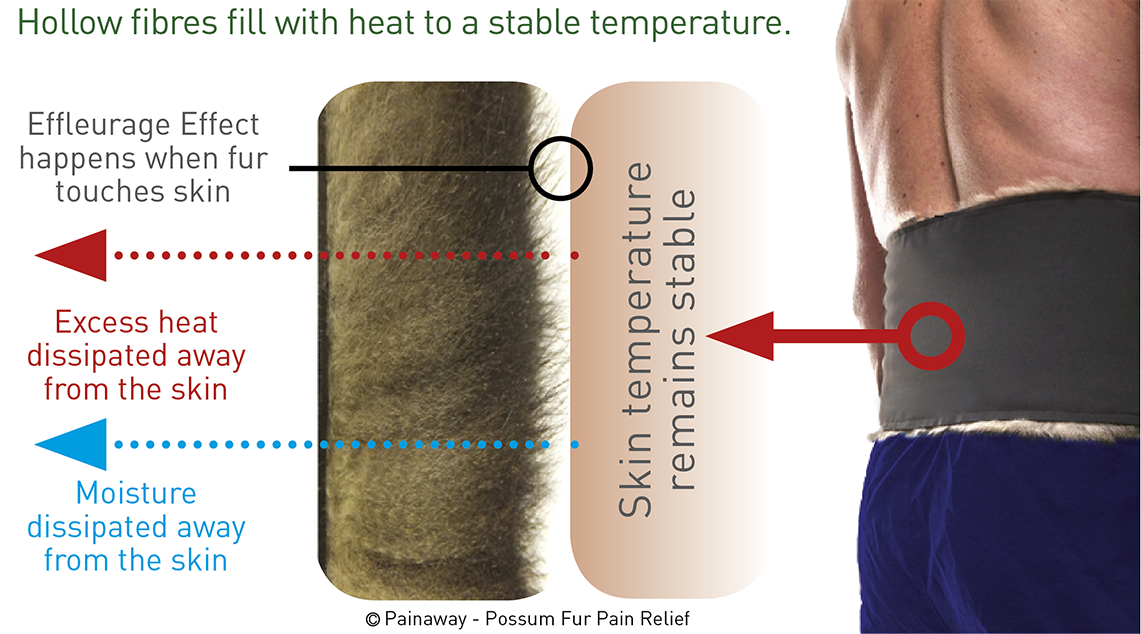
How Much Pain Relief Can I Expect?
Every person is different. However, anecdotal evidence combined with clinical studies and testimonials from a wide number of users suggests that those who currently suffer from intense lower back pain will see a marked reduction. Take the case of two time Olympic gold medallist Mahe Drysdale.
You may not know this but back in 2010 Mahe was in considerable agony following the onset of osteoarthritis. His rowing career was potentially in tatters. There were days when he could not train due to the pain. Then, quite by chance, he discovered the possum belt.
From the first day he wore it, his back felt warmer and freer. He was able to train in the boat more without pain. He has worn it virtually every day since – winning Olympic Gold in 2012 and 2016 while wearing the belt.
Clinical studies carried out in New Zealand from May-July 2014 covering 50 participants with chronic lower back pain showed an average 24.6% decrease in pain intensity. In addition 80% of all participants stated an improvement in being able to carry out their daily duties as well as sleeping better.
The research conclusion was that “Wearing a possum fur back belt for chronic lower back pain significantly decreased pain intensity and improved the ability to perform daily living activities and sleep better.” Some of the comments from those who took part in the survey include:
“Wearing on average 22 hours per day, back feels cared for, really impressed with reduction in pain and medication”
- “So comfortable I forgot I was wearing it”
- “No meds, on feet all day”
- “Belt comfortable – pain getting better”
- “Back feels better since wearing belt”
How Possum Fur Pain Relief was Discovered
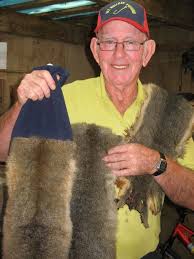
Like many famous discoveries the way in which the Possum Fur Pain Relief belt came about was almost accidental. In the mid-1990s possum fur pioneer Colin Cox and his brother Bo, together with the late Sir Peter Elworthy were developing the possum clothing industry in New Zealand. On a visit to Japan Sir Peter learned that scientists had discovered a similarity between possums and polar bears. It was simply that possum fur had the same thermal qualities as polar bear fur. Rather than being solid as in all other animals, possum and polar bear fur was hollow.
In one of those “Eureka” moments Colin had some seat covers made from possum pelts and after using one at a lengthy meeting felt noticeable pain relief in his lower back. In a further test he made a possum pad to fit his lower back area, tied it around himself and climbed into a cold bath. He remembers that “At first the cold was very intense. However, in a very short time my lower back started to warm up. It was enough to convince me that we were onto something”.
For the next two years Colin and his wife Bev trialled the possum pad belt and found that this fur “breathed”, taking away moisture and perspiration from the skin as it did so. “With wool, fur and other fibres, moisture sits on the tips of the fibre leaving the wearer hot, cold or clammy depending on the exertion”. But, according to Colin, “possum fur seems to arrive at blood heat and then turns off like a thermostat”.
The biggest problem was finding the right material to bind the possum skin and fur around the lower body. It was another two years before material used in mountaineering clothing was found. Then, following five years of trial and error the Cox’s were finally satisfied with their discovery.
The next challenge was getting the message out. Being a person who has worked on or around the land most of his life Colin is the first to admit that he was no marketer and concluded that one of the best ways to gain exposure would be to find a personality, preferably someone in sports, who was known to have a major back problem. One of his friends suggested champion rower Mahe Drysdale (referred to earlier).
Mahe Drysdale
For those who don’t know of him Mahe Drysdale was a New Zealand rowing champion, 5 time world champion and two time Olympic Gold Medallist.

.
There was a time however back in 2010 when Mahe was so incapacitated through osteoarthritis of the lower back that there were days when, on his own admission, he struggled to function and was unable to train. His rowing career was potentially in tatters and the prospects of ever being able to train to the level required to be competitive on the world stage looked increasingly dim.
As he said at the time “I’d tried braces, magnets, deer velvet and health tonics of all description but nothing worked”. It was against this background that, with some trepidation, Colin Cox approached him in 2011. Having already tried everything else Mahe was, not unnaturally, sceptical but agreed to trial the possum belt.
Despite Mahe’s sceptism but to his great delight the belt worked and for the first time in 12 months, he was able to take to the water daily, without discomfort. Mahe asked Colin to make a couple of design modifications to make the belt more streamlined and comfortable while rowing. These were made and the rest as they say is history.
Mahe has worn the possum belt nearly every day from the day he first got it till today. He was wearing it when he won his record equalling fifth world single sculls title in 2011 and later Olympic Gold (single sculls) in both 2012 and 2016.
It should here be stressed that the possum fur pain relief belt does not cure lower back pain. It does exactly as its name suggests. It takes the pain away (to varying degrees) and thereby enables the sufferer to become mobile and to a greater or lesser extent resume their normal duties, such as returning to work, earning a living or getting back into sport and normal daily activities.
Conclusion
No matter how many years you have suffered and put up with lower back pain, chronic or otherwise, you do NOT have to continue this way.
We do not say that you will obtain 100% pain relief or that the belt will cure your arthritis or lower back pain. That is for doctors or complementary health practitioners to sort out.
But the belt can make the pain go away in varying degrees. For Mahe Drysdale it was a game changer; for those on the clinical trials it was a 24.6% average and some wearers have even experienced a 100% reduction in pain. It very much depends on the individual user.
Cost
It’s been said that if a person is suffering from ongoing chronic pain they will pay almost anything to get rid of it. This was confirmed in a recent (USA) study of older chronic pain sufferers (migraine, cancer, arthritis, lower back pain) where the question was asked “Considering your overall satisfaction with life being often troubled by pain, what would you be willing to pay to be just as happy but without the pain?” (Washington Post, August 7, 2017)
The results were surprising to the research team in that responses ranged from US$56-$145 day. That equates to a staggering $20,440-$52,925 (NZ$31,850-82,475) a year which in many cases was virtually a person’s entire income – if not greatly more.
As one reader of the report put it: “I’d be happy just to function normally again, even if in some (ie reduced) pain”. And as a local customer recently said to us “If I only get 10% pain relief I’d be more than happy”.
Given that the possum fur belt has been shown to reduce chronic lower back pain by anything from 25% to as much as 100% and taking into account all costs we still wanted to make the belt as affordable as possible. Accordingly, your one time investment (which for many people will last a life-time) is just $330. There is also a Supergold ‘seniors’ discount of 10% which reduces the cost to $297 (see below). An interest free instalment option of $110 month ($99 to Seniors) over 3 months is also available. Your belt is sent upon receipt of the first payment.
If you wish to take advantage of the Instalment option please indicate where it says ‘Payment Type’ on the Order Form.
This charge would be money extremely well spent even if, as our customer said, the pain was reduced by only 10%. And many customers are reporting 40%-70% and some even 100% relief.
Seniors Discount
If you are aged 65 or over you qualify for a 10% discount. Please click on the SuperGold image top right of this page, enter basic details and you will receive a Coupon Code to enter in the box on the order form. This will reduce your investment to just $297. If choosing the interest free instalment plan, you’ll make an initial payment of $99 followed by 2 monthly payments of $99 (total $297).
This way, cost should not be a factor in your pain relief. Nothing could be fairer than that.
Why stay in pain any longer? Order your belt today and it will be sent to you without delay.
Will the Possum Fur Belt work for me?
If you find that using a hot water bottle, wheatbag or some other source of warmth against your pain affected area helps soothe your aches and pain then the belt will almost certainly work for you.
Whereas you cannot go about your daily activities wearing a hot water bottle or wheatbag (which in any event soon turns cold) you simply wear the belt, fur against skin and your back is kept constantly warm at about 2 degrees above blood temperature.
Many clients wear the belt to bed at night for exactly the same reason and this means that on waking in the morning they don’t have to warm up as their lower back muscles are already warmed and supple.
Choose Your Size
The Painaway belt consists of a generous sized, tanned possum pelt (one possum yields a single pelt) measuring up to 18cm x 44cm firmly sewn onto a black stretch, breathable neoprene belt that covers a wearer’s lower back area.
The belt is extremely comfortable to wear and easy to put on. It is secured by Velcro fastening at the front. The finished belts are produced in a small factory here in New Zealand.
See the photo below showing the extent of fur coverage. Note that the belt is worn with the fur against the skin as in the right hand picture.
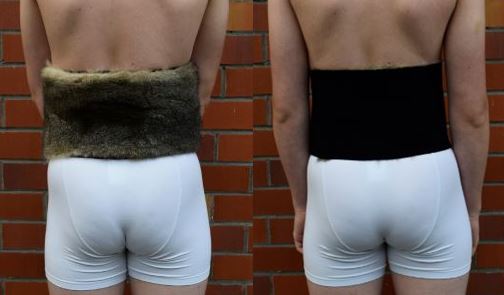
The unstretched belt comes in FOUR lengths covering small (100cm); medium (110cm); large (120cm) and extra large (130cm). When extended and stretched the lengths are:
| Unstretched | Stretched | |
|---|---|---|
| Small | 100cm | 110cm |
| Medium | 110cm | 120cm |
| Large | 120cm | 135cm |
| Extra Large | 130cm | 145cm |
If the circumference of your lower back is greater than 140cm (55 inches) please email us (Info@TeamGroupUK.com) with the subject line “Possum belt” along with the circumference of your lower back and we will give you a quote for your size.
ORDER YOUR BELT HERE
(Orders are normally sent the same day if received before midday. Please allow up to 7 days for delivery during peak periods. If there is going to be any undue delay you will be advised. All orders will be acknowledged).
If, for any reason, you do not wish to use PAYPAL, or are having problems with your card, please phone us on 0800 115 241 or 027 471 2242. We can take VISA or MASTERCARD over the phone.
You may also pay by bank transfer. Call us for bank account details.
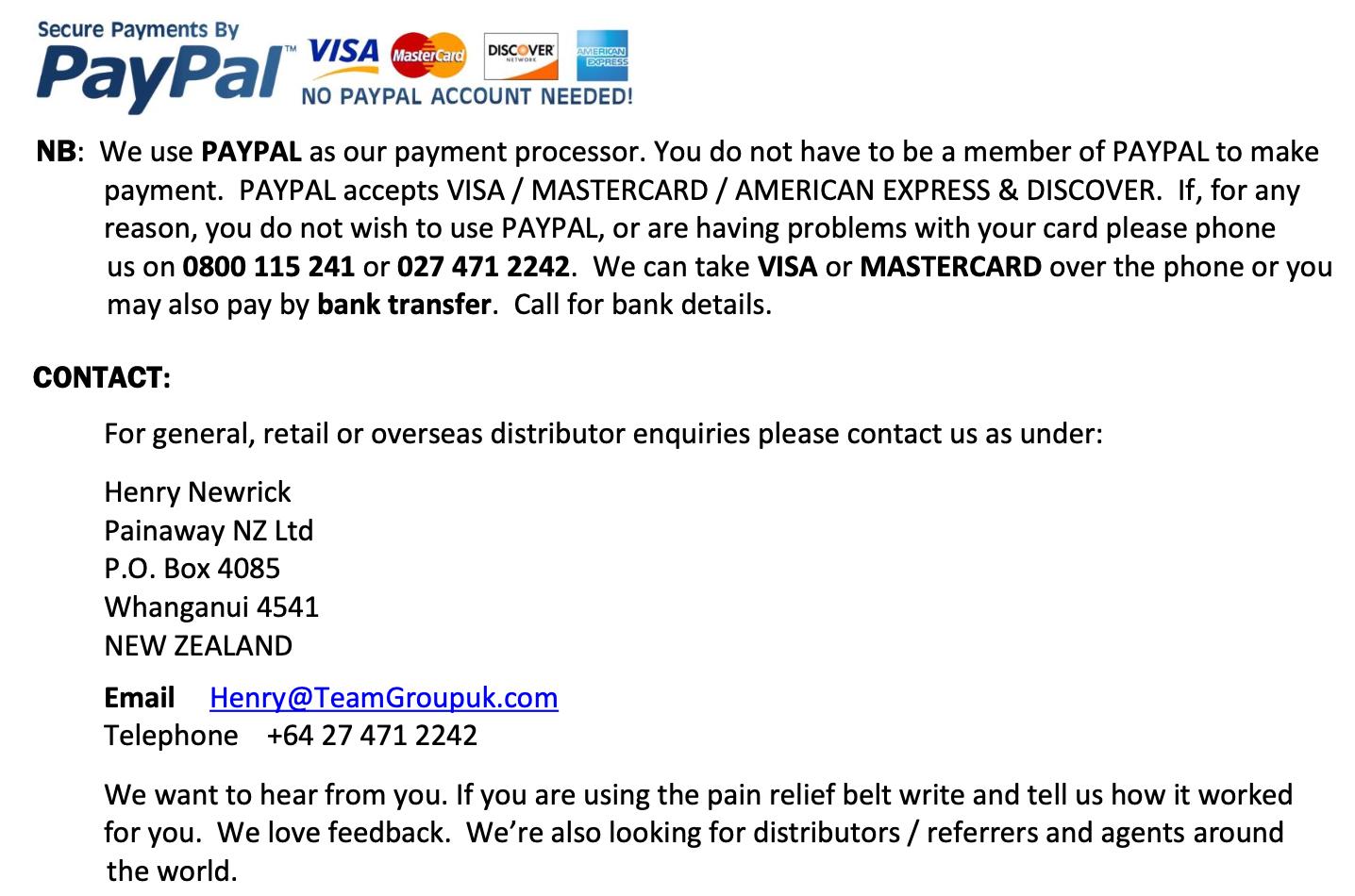
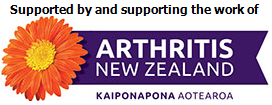
“For a long time I suffered from severe back pain whenever I bent over or did heavy lifting. I recently bought a possum belt which I now wear when I am gardening or doing work that involves lifting.
As I am a keen gardener I make frequent use of the belt which enables me to work without back pain. I couldn’t do without it. I am 86 years young!”
Brian Ingram, Wanganui
“I was confined to bed for over 24 hours with continued pain when lying on my right side, left side or back. In frustration I put on the possum fur belt and the pain disappeared after 30 minutes which enabled me to get a good night’s sleep.
I have been wearing the possum fur back belt for the past two years. I use it when bending, working in the garden and playing bowls. I find it very effective in reducing my lower back pain.”
Doug Salter – Retired Bank Manager
I’m a 67 year old Working Farmer from Taihape. Over 30 years ago I wrecked my back returning a neighbour’s sheep over the fence (when I should have opened the gate). I was in agony. I tried various remedies including chiropractic. Nothing seemed to work.
Some years ago I came across the Possum belt and decided to give it a try. The result has been incredible. When I wear the belt I have virtually no pain at all. If I don’t wear it the pain returns.
I am so impressed with what the belt has done for me that in the past few years I have purchased around 20 belts which I have given to friends and relatives both in New Zealand and overseas who also have back pain.
Fraser Gordon, Taihape
For some years I have been suffering from osteoarthritis. This has caused me considerable pain in my lower back and also affected my sleep. I recently purchased a Painaway possum fur belt to try and lessen the back pain.
I have to say I was very pleased with the result. Very quickly my pain started to go away and I now wear the belt during the day and also to bed at night. If asked to say how much relief I got, I’d say that my arthritis back pain has dropped by about 40% from wearing the belt and I am also able to sleep better at night. In addition to having arthritis I am also diabetic with high blood pressure and kidney failure. Thank you Painaway for letting me know about the belt. It has been life changing.
Isapeli Aholelei, Auckland
As a former Vietnam Veteran there were many occasions both during training and active service where we jumped from helicopters and moving vehicles, carrying heavy packs. This took a toll on our bodies as a result of which I developed severe long term chronic back pain.
Despite years of acupuncture, osteopathy, massage and chiropractic to relieve the pain, nothing has ever really worked and results were always only temporary.
With my Painaway Possum Fur Belt I have finally found something that, combined with exercise, enables me to live without pain. I now enjoy working in the garden, doing household chores and, for the first time in years, having a good night’s sleep – all pain free and absolutely wonderful.
My wife cannot believe the transformation.”
Don Merito
“I purchased one of the possum waist belts to help ease my lower back pain.
The result of wearing the belt has been very interesting. I would not say that it has eliminated the pain entirely but the belt has certainly reduced the lower back pain quite a bit.”
Donald Trott
“I have had lower back pain for many years. A couple of years ago I started wearing a possum belt when walking or jogging. I found I was more comfortable during the activity and had less discomfort afterwards with the belt keeping my lower back warm.
As my lower back arthritis has become more of a problem, I now wear the belt for relief most days. It’s often one of the first things I put on in the morning easing those early morning aches and pains. I’ll also wear it under clothing when I know I’ll be sitting for extended periods.
The belt warms and relaxes the muscles and I would recommend anyone experiencing lower back pain to consider wearing one.”
Jim Pring
“I am 73 years of age and am in recovery from 3 major operations over 4 years, including cancer & heart.
I am getting back into activities that are best for my physical recovery such as cycling, paddling, waka ama and sculling. I have found these challenging as the easiest option is of course to put the feet up.
The pain that is most regular is lower back pain. Prior to trialling the possum belt I was very doubtful that I would be able to minimise the pain and thus be able to sustain the exercise over time. Not so and I now use the belt constantly. The result is that I am back to largely pain free movement. This has made a huge change to my wellness as I find sensible exercise the key difference between wellness and depression.”
Roderick Trott, Whanganui
I have had lower back pain for many years from my early motor cycle racing days in the 1940s and 1950s.
I recently ordered a Painaway Possum Fur Belt but returned it after a week thinking that I hadn’t gained any pain relief. After a few days I realised I was mistaken. The pain was back. The pain level between wearing the belt and not wearing it was significant.
If you purchase the belt and are in any doubt as to whether it is working or not, wear it for a while – and then don’t wear it for some days. Measure the difference – before deciding whether it’s for you or not.
Rod Coleman – National & International Motor Cycle Champion (Winner – Isle of Man TT, 1954)
About 80% of adults experience low back pain at some point in their lives.
Low back pain impacts an estimated 540 million people across the globe, and most are treated in a manner that is not consistent with best practice guidelines. Low back pain is a major problem throughout the world and is getting worse – largely because of the aging population.
The Lancet.
Low back pain is an extremely common symptom that affects all age groups making it the most common disability worldwide.
Jan Hartvigsen PhD (back pain specialist)
The human cost globally of low back pain is much higher than previously estimated.
James McDeavitt MD(Chair of Physical Medicine, Baylor College)
Although they may strongly advocate surgery, back pain surgeons “do not want to go under the knife themselves. At an American Academy of Orthopaedic Surgeons conference in the summer of 2010, a hundred surgeons were polled as to whether they’d personally have lumbar spinal fusion surgery for unspecific low back pain. The answer – from all but one – was ‘absolutely not’. The risk-reward ratio just wasn’t good enough.”
From Crooked – Outwitting the Back Pain Industry by Cathryn Jakobson Ramin
In the United Kingdom, low back pain was identified as the most common cause of disability with more than 100 million workdays lost each year. In Sweden low back pain accounted for a quadrupling of the number of workdays lost from 7 million in 1980 to 28 million by 1987. However it is believed that the existence of social compensation systems in Sweden might account for some of this increase.
In the United States, an estimated 149 million workdays are lost every year because of low back pain with total costs estimated to be US$100 -US$200 billion a year.
Source: World Health Organisation Report on Lower Back Pain 2013

